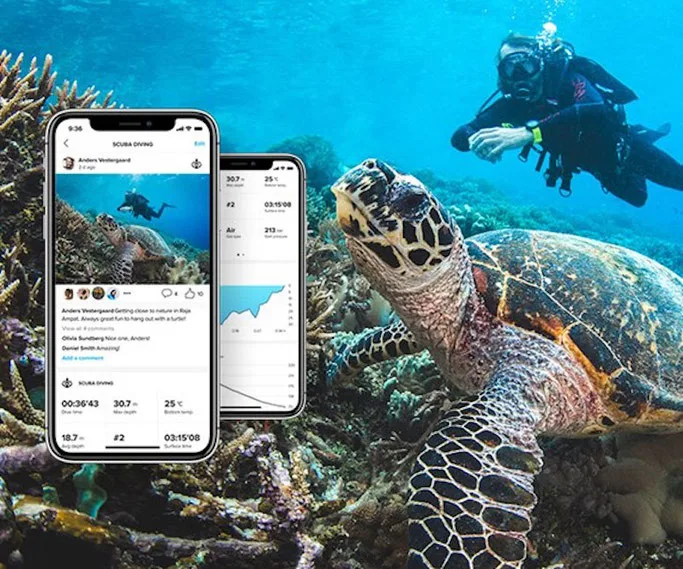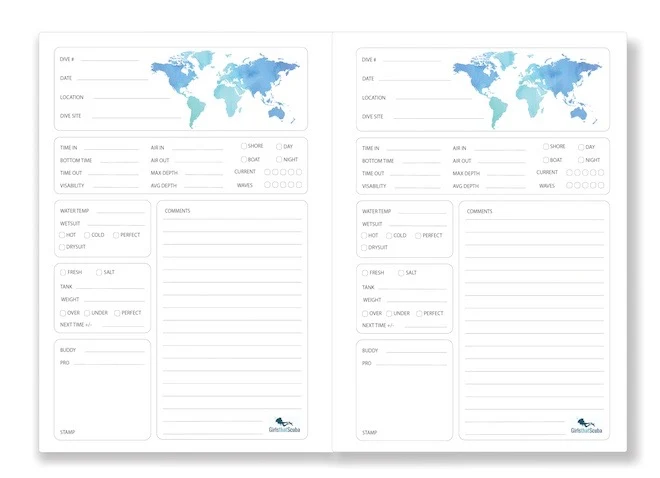We’ve all met that scuba diver who passionately tells us they’ve logged all 732 of their dives, and whilst some of us feel envious that they have their dive history at their hands, others see logging as a chore. However, logging your scuba dives doesn’t have to be difficult, time-consuming, or complicated.
So here’s a GTS lowdown on dive logs – why you should log your dives, what you should be recording in your logbook, and the best options for keeping track of your underwater adventures – from classic paper logs to Bluetooth enabled dive log apps.
First up, why should I log my dives?
Ask around and divers can offer up a myriad of reasons why you should be logging your dives. Some are more practical, whilst some are more sentimental. There’s no right or wrong motivation, so here’s a selection of the best reasons why you should keep your dive log up to date.
Having a log proves your dive experience
This comes in handy when diving somewhere new; you could simply tell a new buddy or instructor that you have 50 dives including night dives and boat dives, but it’s more valuable to have that information written down and verified by a pro or buddy’s signature. Certain situations may require a specific number of logged dives, such as advanced dives in challenging conditions, enrolling on a tech course, or beginning your Divemaster or Instructor education.
We all love a scrapbook
For some divers, a dive log serves as a sentimental scrapbook or diary of their experiences. It’s rewarding to look back and remember specific dives – be it a funny memory with a favourite buddy, the first time you visited a world-class wreck, or a special encounter with a rare marine creature.
Planning for the future
Depending on what information you track, your dive log can make future dive planning easier and allow you to see progression over time. A great example is logging your air consumption; you will be able to see the improvement in how much gas you use, as well as noticing what impact other factors such as temperature or water conditions have on your consumption. This will make you a better, more self-aware diver!
What information should a dive log include?
The level of detail you choose to go into in your dive log is just as personal as why you keep it. It could be the bare-bones of your dive, or a detailed diary entry of who you dived with, what you saw, and how you felt.
These are some elements you may want to include to make your dive log work the best for you. At their simplest, your entries should cover the basics of your dive – date, location, maximum depth, average depth, time in and time out, start and end tank pressures, and temperature. If you’re simplifying your log you can stick to these fundamentals; perhaps you’re a regular diver or a dive pro who’s no longer in need of additional information, or maybe you’d rather get started on post-dive socialising than spend ages with your head in your logbook!
However, going into more detail can be rewarding, particularly when it comes to weights. If you’re a travel diver who frequents different locations – flitting between warm and cold water, or diving with different cylinders – getting your weighting correct is a minefield. If you take the time to log exposure suit type, thickness, cylinder size and material (steel or aluminium), and amount of weight carried, your dive log becomes a fantastic tool when working out how much weight you need for a new location.
Want to take it one step further? Use a 1-5 rating to note how your buoyancy felt with that weight in those particular conditions!
Finally, most dive logs include a notes section, which can be used however you choose! Some divers get creative with these notes sections, including artistic illustrations or funny notes to their buddy.
Many of us track our creature sightings and experiences, or detail our training dives for different courses or specialities. To really maximise your dive log’s value, note down feedback from your instructor or divemaster, advice from helpful buddies, or self-reflection on your own dive skills.
Physical log books vs Apps
Like anything else in diving, there are many different choices for how to log dives. We can categorise these into paper dive logs, or smart dive logs using technology to streamline the process. Read on to find out the GTS faves for each!
Paper log books
For those of you who love putting pen to paper, we love our GTS Dive Log Book – designed with GTS members in mind. Consider this an amped-up version of the logbook you may have been given on your Open Water Course. It’s easy to use, with space for all the important information, and made with recycled paper to give it a big tick in the eco-friendly box. There’s space to log 38 dives in this travel-sized book, and in true GTS fashion it’s stuffed with inspiring quotes on beautiful pages!
For something more sizeable and customisable, check out Dive Proof. These waterproof books can be personalised with your choice of cover photograph – from their archives or your own underwater snaps. Additionally, they have seven options for page styles to suit your needs, whether you’re a beginner, a working dive pro, or tech diver! Check out our full review here.
Dive Proof is one of the many brands offering amazing discounts to Girls that Scuba through our exclusive Membership Card. Click here for more information on the hundreds of dive centres, liveaboards and scuba brands involved, and to get your Dive Proof discount!

Smart Dive Logs
Don’t let us lose you with “smart”, this could be as simple as a spreadsheet on your laptop. With a little computer know-how this option provides great customisability; it can be as information-rich as you choose to make it, and can give some great analysis of your dive statistics!
Many dive computers simplify this process by having their own PC/Mac interface, meaning you can simply plug in your dive computer and watch the information appear on your screen. However, some brands require you to buy the cable separately from the dive computer.
Some top-of-the-range dive computers come equipped with Bluetooth and their own logging apps. What could be easier than syncing your dive computer to a log on your smartphone? If you’d like your dive details at your fingertips, models such as the Suunto D5, Garmin Descent, and Shearwater Teric offer this intelligent feature.
If you already have a non-Bluetooth dive computer there are still mobile apps which you can use to simplify your logging. A few GTS favourites include Subsurface and Divemate, both available on Android and iOS. Divemate’s clever tool can connect to the USB cables of over 160 different computers, allowing most computers to mimic newer Bluetooth models.
Have we inspired you to try a different dive log, add something new to your existing dive diary, or pick up a pen after a break from logging? Let us know in the comments below, or show off your beautiful dive log pages by tagging @girlsthatscuba on Instagram!

About the author – our GTS blogger Lauren
Lauren originally learned to dive in 2008, and her heart has been in the ocean ever since. In 2018 her sense of adventure and passion for the underwater world led her to Indonesia, where she completed her PADI Divemaster and Instructor qualifications. You can find her on Instagram @laurennn_elizabeth to follow where the currents take her next!




